
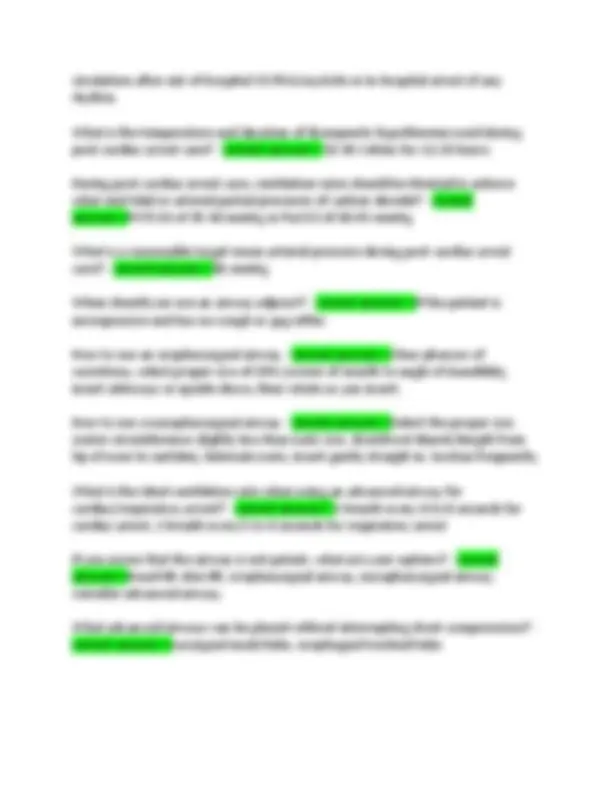
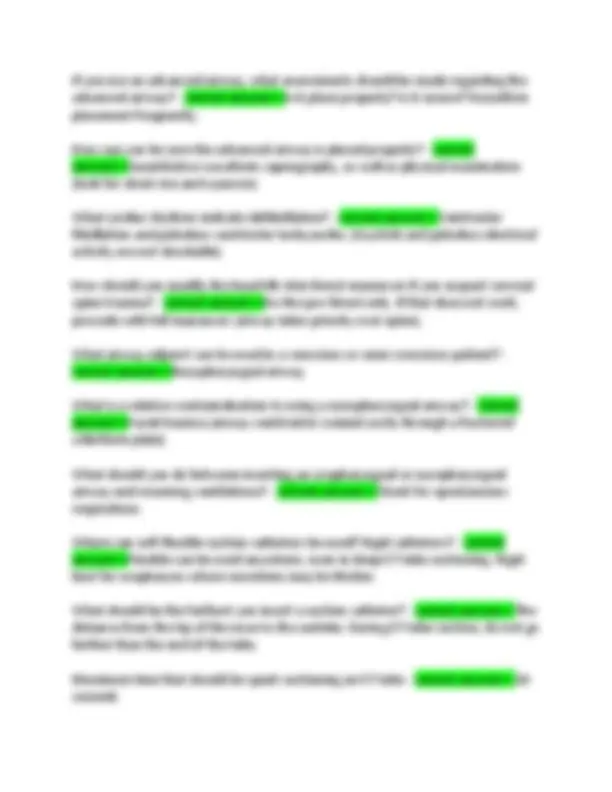
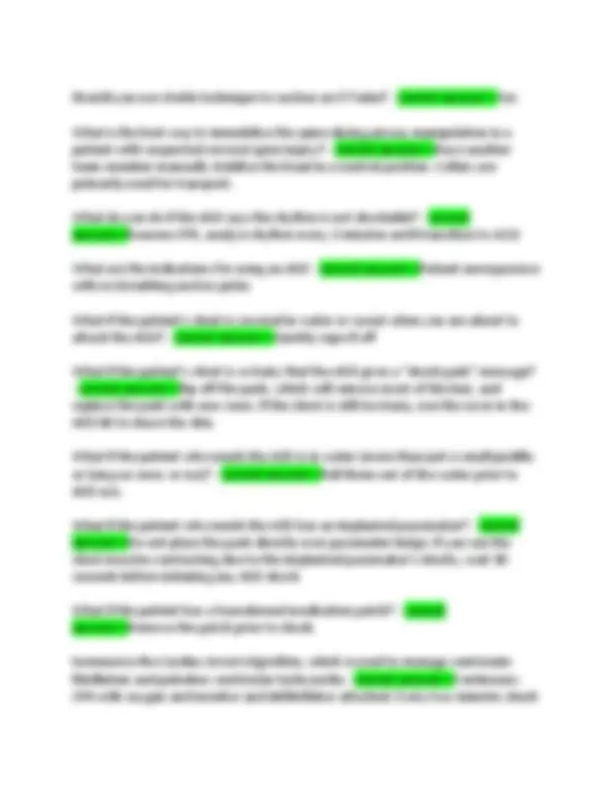
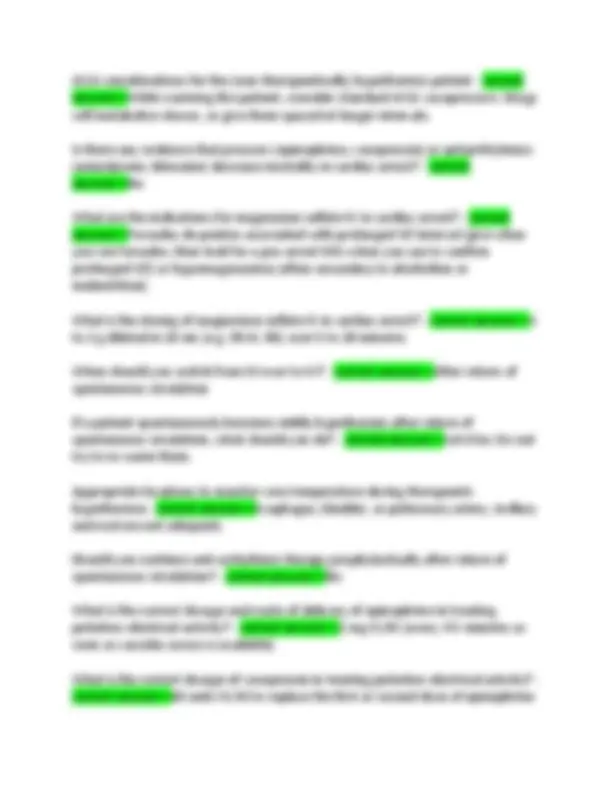
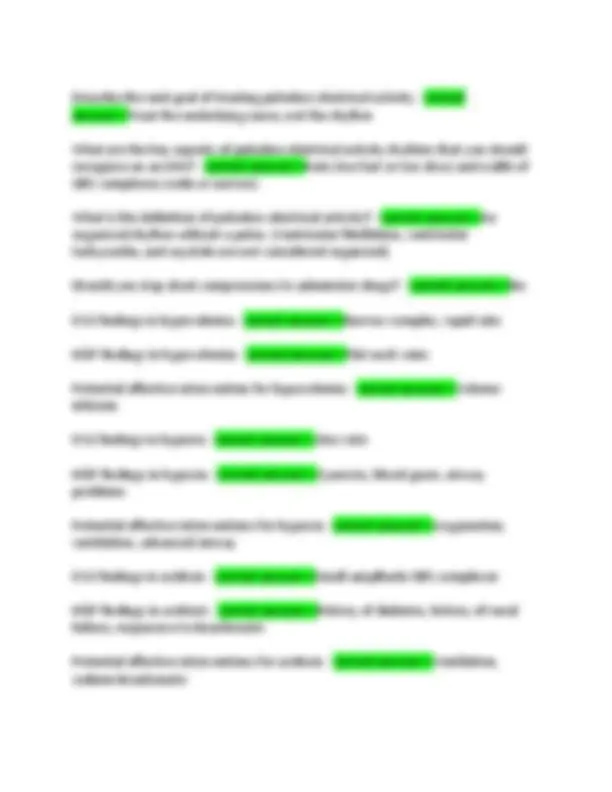
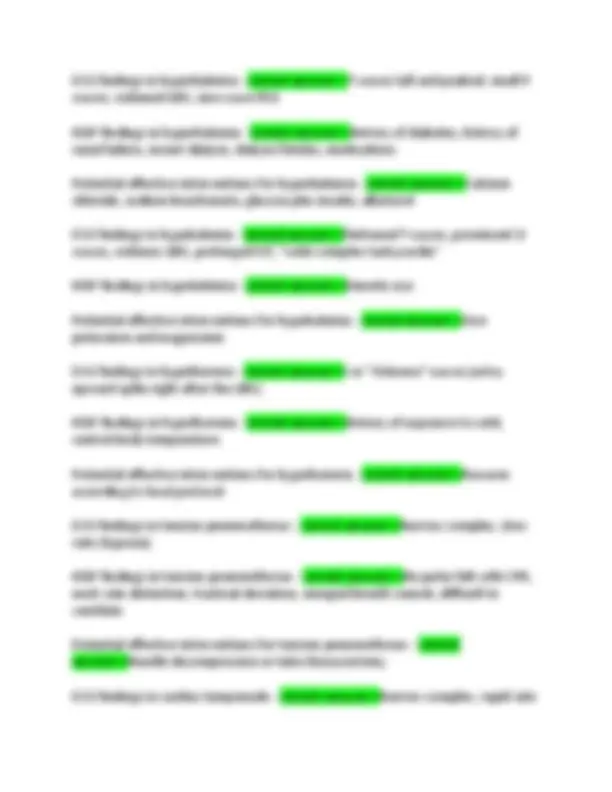
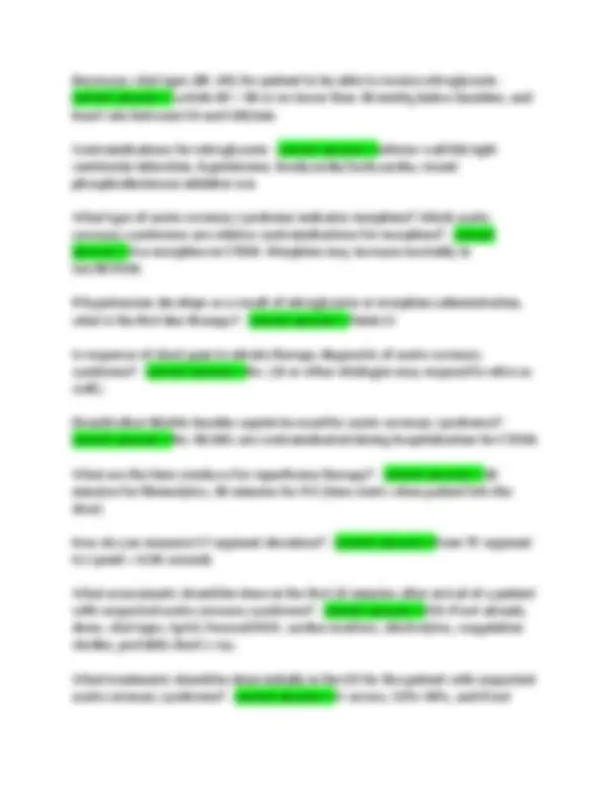
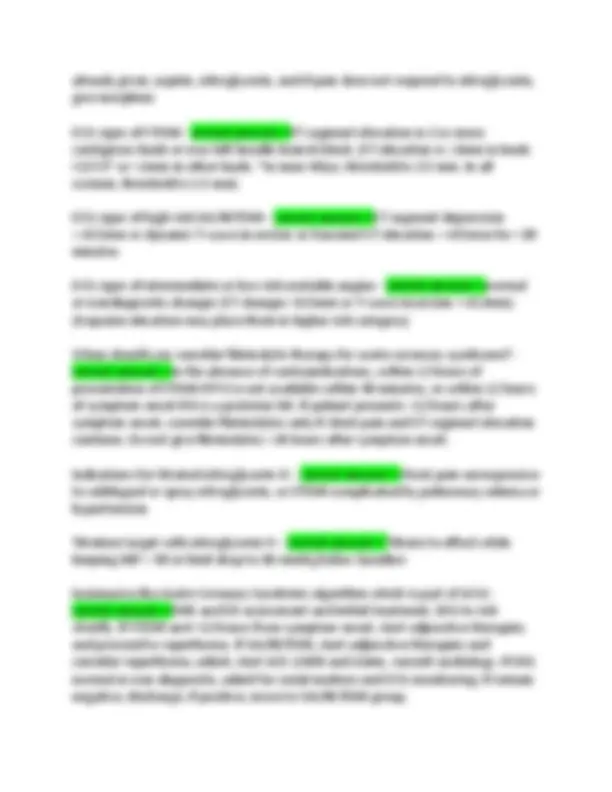
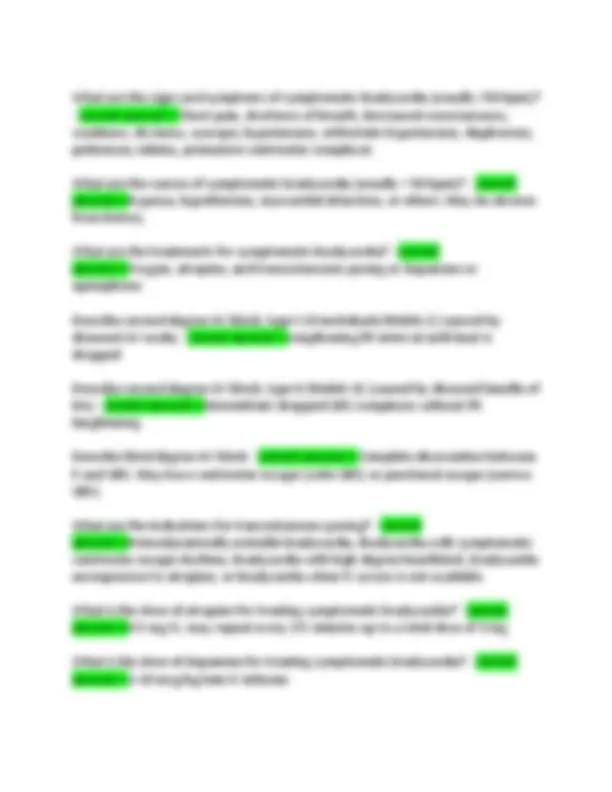
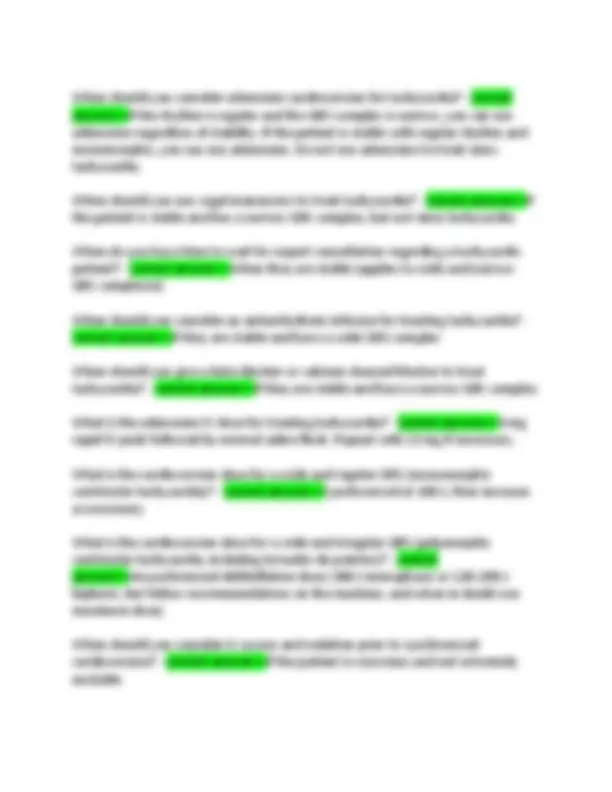
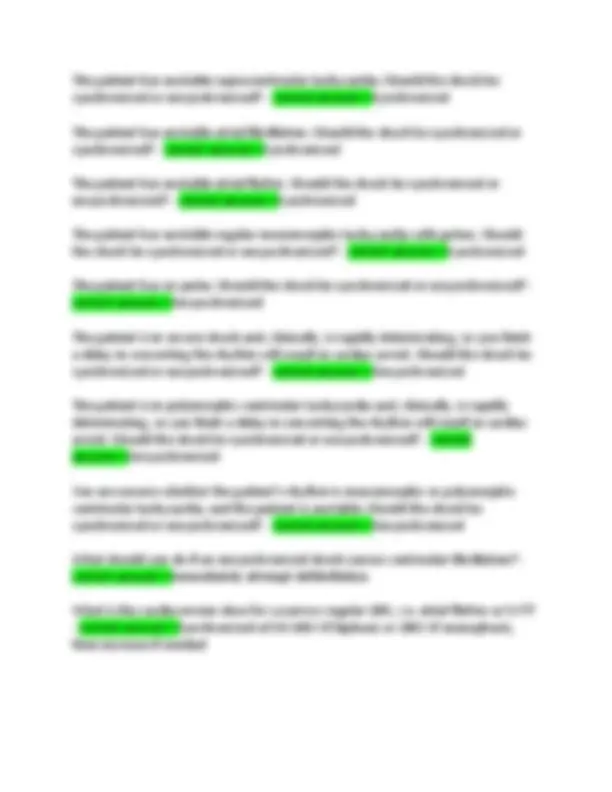
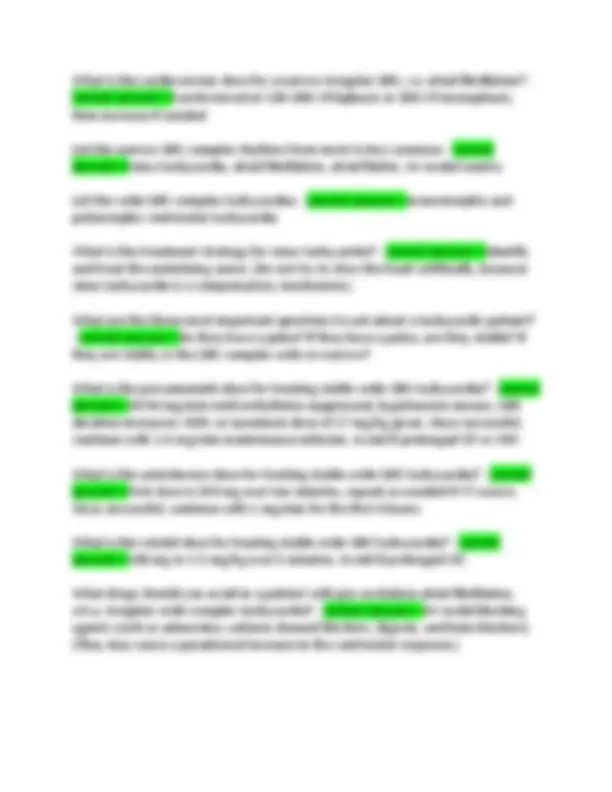
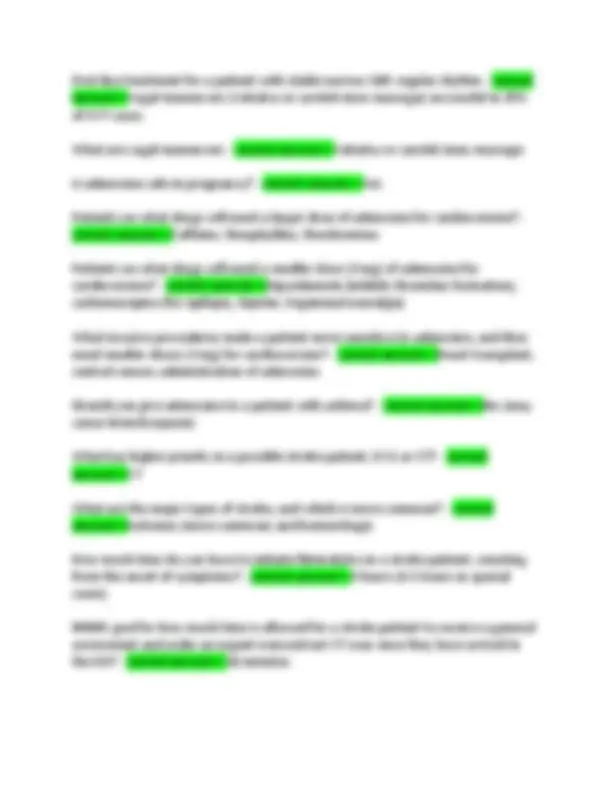
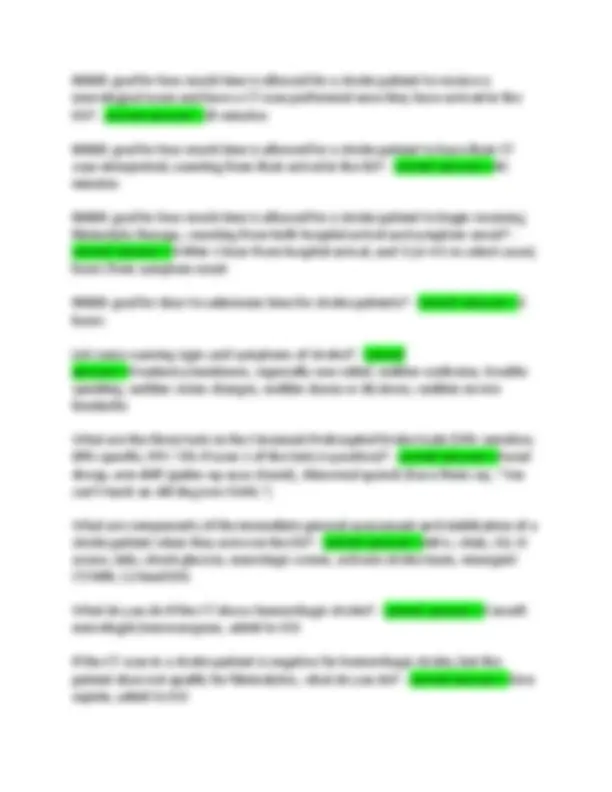
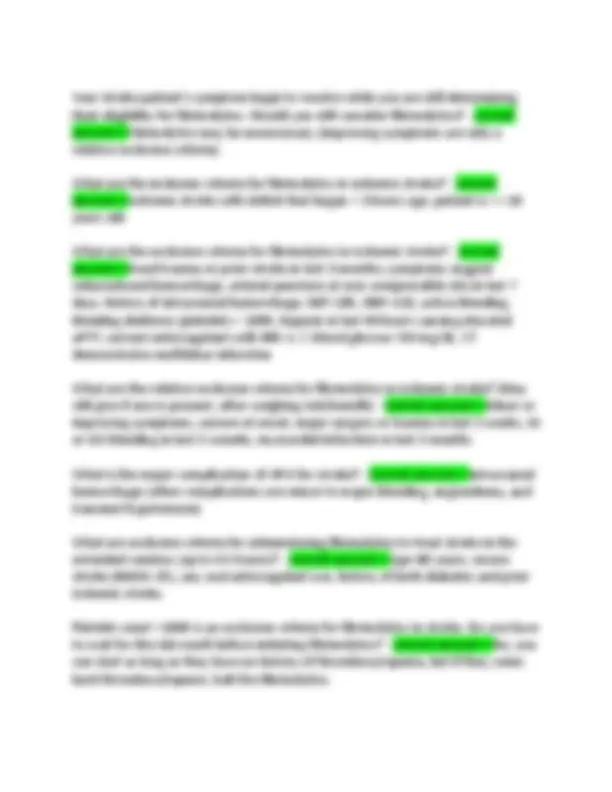
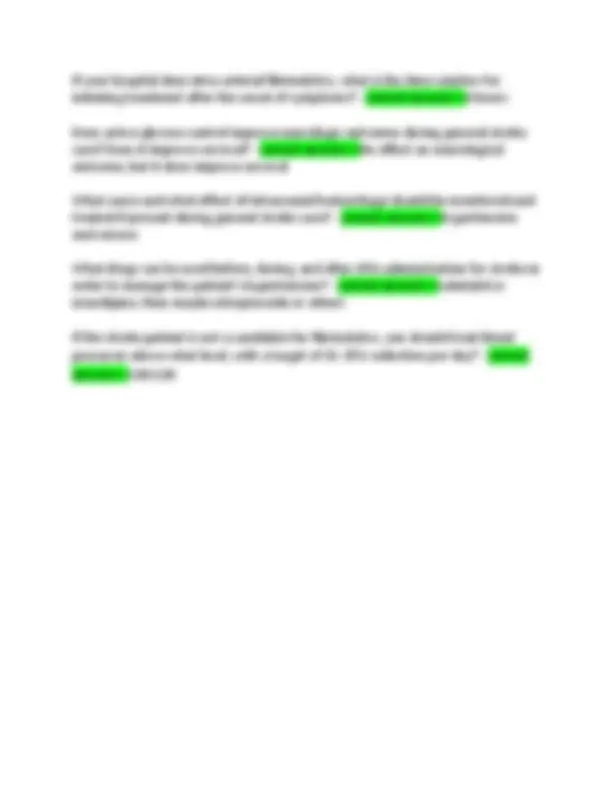


Study with the several resources on Docsity

Earn points by helping other students or get them with a premium plan


Prepare for your exams
Study with the several resources on Docsity

Earn points to download
Earn points by helping other students or get them with a premium plan
Community
Ask the community for help and clear up your study doubts
Discover the best universities in your country according to Docsity users
Free resources
Download our free guides on studying techniques, anxiety management strategies, and thesis advice from Docsity tutors
ACLS Latest Final Exam 2025-2026 With Verified Questions and Correct Answers What determines whether you should use the BLS or ACLS initial survey? - correct answer>>If the patient is unconscious use the BLS survey, if they are conscious, use the ACLS survey. (Once you have completed the BLS survey on an unconscious patient, initiate the ACLS survey for more advanced assessment and treatment.) What is step 1 of BLS? - correct answer>>Check that scene is safe, then check responsiveness and breathing What is step 2 of BLS - correct answer>>Call EMS and get an AED What is step 3 of BLS? - correct answer>>Check pulse. If absent, begin compressions. If present, rescue breathing with periodic pulse checks. What is step 4 of BLS? - correct answer>>Use AED/defibrillator asap. Resume compressions after each shock. (Don't stop to check pulse or respirations at this point. It may take a couple minutes for the pulse to return even after a successful defibrillation.)
Typology: Exams
1 / 24

This page cannot be seen from the preview
Don't miss anything!

















What determines whether you should use the BLS or ACLS initial survey? - correct answer>>If the patient is unconscious use the BLS survey, if they are conscious, use the ACLS survey. (Once you have completed the BLS survey on an unconscious patient, initiate the ACLS survey for more advanced assessment and treatment.) What is step 1 of BLS? - correct answer>>Check that scene is safe, then check responsiveness and breathing What is step 2 of BLS - correct answer>>Call EMS and get an AED What is step 3 of BLS? - correct answer>>Check pulse. If absent, begin compressions. If present, rescue breathing with periodic pulse checks. What is step 4 of BLS? - correct answer>>Use AED/defibrillator asap. Resume compressions after each shock. (Don't stop to check pulse or respirations at this point. It may take a couple minutes for the pulse to return even after a successful defibrillation.) What questions should you ask when assessing an airway as part of the ACLS survey? - correct answer>>Is the airway patent? Is an advanced airway indicated? Is proper placement of airway device confirmed? Is tube secured and placement reconfirmed frequently? What is a Class I recommendation for confirming proper placement of an ET tube, and can be used for confirming supraglottic airway placement? - correct answer>>Quantitative waveform capnography What questions should you ask when assessing breathing as part of the ACLS survey? - correct answer>>Are ventilation and oxygenation adequate? Are quantitative waveform capnography and oxyhemoglobin saturation monitored? What FiO2 should be administered during initial resuscitation of cardiac arrest patients? - correct answer>>100%
How much oxygen should be given to non-cardiac arrest patients as part of the ACLS survey? - correct answer>>Titrate oxygen to achieve O2 saturation of 94% by pulse oximetry What clinical criteria give you an idea of whether ventilation and oxygenation are adequate? - correct answer>>Chest rise, cyanosis What questions should you ask when assessing circulation as part of the ACLS survey? - correct answer>>Are chest compressions effective? What is the cardiac rhythm? Is defibrillation or cardioversion indicated? Has IV/IO access been established? Has circulation spontaneously returned? If they do have a pulse, are they stable? Are medications needed for rhythm or blood pressure? Does the patient need volume (fluid) resuscitation? What objective measues indicate inadequate quality of chest compressions? - correct answer>>End-tidal partial pressure of carbon dioxide < 10 mmHg, and intra-arterial diastolic pressure < 20 mmHg What questions should you ask when assessing the differential diagnosis as part of the ACLS survey? - correct answer>>Why did this patient develop symptoms or arrest? Is there a reversible cause that can be treated? How can the team leader maintain closed-loop communications? - correct answer>>1) Give a clear order 2) Receive clear response that the team member heard and understood 3) Get confirmation of task completion before assigning another task How can the team members maintain closed-loop communications? - correct answer>>Verbally confirm drug orders prior to administration, and inform the team leader when the ordered task has been completed. What roles should be assigned in an ACLS team? - correct answer>>Team leader, airway, compressor, monitor/defibrillator, IV/IO meds, observer/recorder Who should be treated with therapeutic hypothermia as part of post-cardiac arrest care? - correct answer>>Comatose patients with return of spontaneous
If you use an advanced airway, what assessments should be made regarding the advanced airway? - correct answer>>Is it place properly? Is it secure? Reconfirm placement frequently. How can you be sure the advanced airway is placed properly? - correct answer>>Quantitative waveform capnography, as well as physical examination (look for chest rise and cyanosis) What cardiac rhythms indicate defibrillation? - correct answer>>Ventricular fibrillation and pulseless ventricular tachycardia. (Asystole and pulseless electrical activity are not shockable) How should you modify the head tilt-chin thrust maneuver if you suspect cervical spine trauma? - correct answer>>Do the jaw thrust only. If that does not work, procede with full maneuver (airway takes priority over spine). What airway adjunct can be used in a conscious or semi-conscious patient? - correct answer>>Nasopharyngeal airway What is a relative contraindication to using a nasopharyngeal airway? - correct answer>>Facial trauma (airway could enter crainial cavity through a fractured cribriform plate) What should you do between inserting an oropharyngeal or nasopharyngeal airway and resuming ventilations? - correct answer>>Check for spontaneous respirations Where can soft flexible suction catheters be used? Rigid catheters? - correct answer>>Flexible can be used anywhere, even in deep ET tube suctioning. Rigid best for oropharynx where secretions may be thicker. What should be the farthest you insert a suction catheter? - correct answer>>The distance from the tip of the nose to the earlobe. During ET tube suction, do not go farther than the end of the tube. Maximum time that should be spent suctioning an ET tube - correct answer>> 10 seconds
Should you use sterile technique to suction an ET tube? - correct answer>>Yes What is the best way to immobilize the spine during airway manipulation in a patient with suspected cervical spine injury? - correct answer>>Have another team member manually stabilize the head in a neutral position. Collars are primarily used for transport. What do you do if the AED says the rhythm is not shockable? - correct answer>>Resume CPR, analyze rhythm every 2 minutes until transition to ACLS What are the indications for using an AED - correct answer>>Patient unresponsive with no breathing and no pulse What if the patient's chest is covered in water or sweat when you are about to attach the AED? - correct answer>>Quickly wipe if off What if the patient's chest is so hairy that the AED gives a "check pads" message?
After return of spontaneous circulation, how do you assess for a STEMI? If it is a STEMI, what intervention should you take? - correct answer>>Get a 12 lead EKG. If STEMI, initiate coronary reperfusion, e.g. percutaneous coronary intervention After return of spontaneous circulation, how do you assess level of consciousness? What intervention should you initiate if they do not have adequate consciousness? - correct answer>>Based on the patient's ability to follow commands. If they cannot, initiate therapeutic hypothermia. After return of spontaneous circulation, how do you place the patient into the appropriate system of care? - correct answer>>Admit to ICU Should you resume chest compressions while the manual or automatic defibrillator is charging? - correct answer>>Yes When should you do a pulse check during ACLS Cardiac arrest? - correct answer>>Every two minutes if there is an organized but nonschockable rhythm Signs of return of spontaneous circulation (besides feeling a pulse. These things can be monitored without interrupting chest compressions) - correct answer>>Abrupt sustained increase in end-tidal partial pressure of carbon dioxide to over 40 mmHg, spontaneous arterial pressure waves with intra-arterial monitoring, blood pressure improves What drug can you substitute for the first or second dose of epinephrine in the ACLS cardiac arrest algorithm? - correct answer>>40 units vasopressin IV/IO Name 10 reversible causes of cardiac arrest (hint: 5 start with H and 5 start with T) - correct answer>>Hypovolemia, hypoxia, hydrogen ion (acidosis), hypo/hyperkalemia, hypothermia, tension pneumothorax, tamponade (cardiac), toxins, thrombosis (pulmonary), thrombosis (coronary) What should you inject immediately after administering ACLS drugs during CPR? - correct answer>>20 mL bolus of IV fluid, then elevate the extremity 10 to 20 seconds to help drug reach central circulation.
ACLS considerations for the (non-therapeutically) hypothermic patient - correct answer>>While warming the patient, consider standard ACLS vasopressors. Drugs will metabolize slower, so give them spaced at longer intervals. Is there any evidence that pressors (epinephrine, vasopressin) or antiarrhtyhmics (amiodarone, lidocaine) decrease mortality in cardiac arrest? - correct answer>>No What are the indications for magnesium sulfate IV in cardiac arrest? - correct answer>>Torsades de pointes associated with prolonged QT interval (give when you see torsades, then look for a pre-arrest EKG when you can to confirm prolonged QT) or hypomagnesemia (often secondary to alcoholism or malnutrition) What is the dosing of magnesium sulfate IV in cardiac arrest? - correct answer>> 1 to 2 g diluted in 10 mL (e.g. D5W, NS) over 5 to 20 minutes When should you switch from IO over to IV? - correct answer>>After return of spontaneous circulation If a patient spontaneously becomes mildly hypothermic after return of spontaneous circulation, what should you do? - correct answer>>Let it be. Do not try to re-warm them. Appropriate locations to monitor core temperature during therapeutic hypothermia - correct answer>>Esophagus, bladder, or pulmonary artery. Axillary and oral are not adequate. Should you continue anti-arrhythmic therapy prophylactically after return of spontaneous circulation? - correct answer>>No What is the correct dosage and route of delivery of epinephrine in treating pulseless electrical activity? - correct answer>>1 mg IV/IO (every 3-5 minutes as soon as vascular access is available) What is the correct dosage of vasopressin in treating pulseless electrical activity? - correct answer>>40 units IV/IO to replace the first or second dose of epinephrine
ECG findings in hyperkalemia - correct answer>>T waves tall and peaked, small P waves, widened QRS, sine-wave PEA H&P findings in hyperkalemia - correct answer>>History of diabetes, history of renal failure, recent dialysis, dialysis fistulas, medications Potential effective interventions for hyperkalemia - correct answer>>Calcium chloride, sodium bicarbonate, glucose plus insulin, albuterol ECG findings in hypokalemia - correct answer>>Flattened T waves, prominent U waves, widenes QRS, prolonged QT, "wide-complex tachycardia" H&P findings in hypokalemia - correct answer>>Diuretic use Potential effective interventions for hypokalemia - correct answer>>Give potassium and magnesium ECG findings in hypothermia - correct answer>>J or "Osborne" waves (extra upward spike right after the QRS) H&P findings in hypothermia - correct answer>>History of exposure to cold, central body temperature Potential effective interventions for hypothermia - correct answer>>Rewarm according to local protocol ECG findings in tension pneumothorax - correct answer>>Narrow complex, slow rate (hypoxia) H&P findings in tension pneumothorax - correct answer>>No pulse felt with CPR, neck vein distention, tracheal deviation, unequal breath sounds, difficult to ventilate Potential effective interventions for tension pneumothorax - correct answer>>Needle decompression or tube thoracostomy ECG findings in cardiac tamponade - correct answer>>Narrow complex, rapid rate
H&P findings in cardiac tamponade - correct answer>>No pulse felt with CPR, vein distention Potential effective interventions for cardiac tamponade - correct answer>>Pericardiocentesis ECG findings in toxicity (drug overdose): tricyclics, digoxin, beta blockers, calcium channel blockers - correct answer>>Various, but predominately QT prolongation H&P findings in drug toxicity - correct answer>>Bradycardia, empty bottles at the scene, pupils, abnormal neurologic findings Potential effective interventions for cardiac arrest due to drug toxicity - correct answer>>Intubation, specific antidotes ECG findings in massive pulmonary embolism (Thrombosis, lungs) - correct answer>>Narrow complex, rapid rate H&P findings in pulmonary embolism - correct answer>>No pulse with CPR, distended neck veins, prior positive test for DVT or PE Potential effective interventions for pulmonary embolism - correct answer>>Surgical embolectomy, fibrinolytics ECG findings in Thrombosis, heart (aka massive acute MI) - correct answer>>Q waves, ST changes, T wave inversions H&P findings in acute, massive MI (Thrombosis, heart) - correct answer>>Cardiac markers, good pulse with CPR Causes of cardiac arrest in which no pulse is felt during CPR - correct answer>>Tension pneumothorax, cardiac tamponade, pulmonary embolism What is the meaning of narrow complexes on the ECG during cardiac arrest? - correct answer>>The cause is likely noncardiac
Necessary vital signs (BP, HR) for patient to be able to receive nitroglycerin - correct answer>>systolic BP > 90 or no lower than 30 mmHg below baseline, and heart rate between 50 and 100/min Contraindications for nitroglycerin - correct answer>>Inferior wall MI/right ventricular infarction, hypotension, bradycardia/tachycardia, recent phosphodiesterase inhibitor use What type of acute coronary syndrome indicates morphine? Which acute coronary syndromes are relative contraindications for morphine? - correct answer>>Use morphine in STEMI. Morphine may increase mortality in UA/NSTEMI. If hypotension develops as a result of nitroglycerin or morphine administration, what is the first line therapy? - correct answer>>Fluids IV Is response of chest pain to nitrate therapy diagnostic of acute coronary syndrome? - correct answer>>No. (GI or other etiologies may respond to nitro as well.) Should other NSAIDs besides aspirin be used for acute coronary syndrome? - correct answer>>No. NSAIDs are contraindicated during hospitalization for STEMI. What are the time windows for reperfusion therapy? - correct answer>> 30 minutes for fibrinolytics, 90 minutes for PCI (time starts when patient hits the door) How do you measure ST segment deviation? - correct answer>>from TP segment to J point + 0.04 seconds What assessments should be done in the first 10 minutes after arrival of a patient with suspected acute coronary syndrome? - correct answer>>EKG if not already done, vital signs, SpO2, focused H&P, cardiac markers, electrolytes, coagulation studies, portable chest x-ray. What treatments should be done initially in the ED for the patient with suspected acute coronary syndrome? - correct answer>>IV access, O2%>94%, and if not
already given, aspirin, nitroglycerin, and if pain does not respond to nitroglycerin, give morphine ECG signs of STEMI - correct answer>>ST segment elevation in 2 or more contiguous leads or new left bundle branch block. (ST elevation is >2mm in leads V2/V3* or >1mm in other leads. *In men<40yo, threshold is 2.5 mm. In all women, threshold is 1.5 mm) ECG signs of high-risk UA/NSTEMI - correct answer>>ST segment depression
=0.5mm or dynamic T-wave inversion or transient ST elevation >=0.5mm for < minutes ECG signs of intermediate or low-risk unstable angina - correct answer>>normal or nondiagnostic changes (ST changes <0.5mm or T-wave inversion <=0.2mm) (troponin elevation may place them in higher risk category) When should you consider fibrinolytic therapy for acute coronary syndrome? - correct answer>>In the absence of contraindications, within 12 hours of presentation of STEMI if PCI is not available within 90 minutes, or within 12 hours of symptom onset if it is a posterior MI. If patient presents >12 hours after symptom onset, consider fibrinolytics only if chest pain and ST segment elevation continue. Do not give fibrinolytics >24 hours after symptom onset. Indications for titrated nitroglycerin IV - correct answer>>Chest pain unresponsive to sublingual or spray nitroglycerin, or STEMI complicated by pulmonary edema or hypertension Titration target with nitroglycerin IV - correct answer>>Titrate to effect while keeping SBP > 90 or limit drop to 30 mmHg below baseline Summarize the Acute Coronary Syndroms algorithm which is part of ACLS - correct answer>>EMS and ED assessment and initial treatment, EKG to risk stratify. If STEMI and <12 hours from symptom onset, start adjunctive therapies
and proceed to reperfusion. If UA/NSTEMI, start adjunctive therapies and consider reperfusion, admit, start ACE-i/ARB and statin, consult cardiology. If EKG normal or non-diagnostic, admit for serial markers and ECG monitoring: if remain negative, discharge, if positive, move to UA/NSTEMI group.
What is the dose of epinephrine for treating symptomatic bradycardia? - correct answer>> 2 - 10 mcg/kg/min IV infusion What bradycardic rhythms should not receive atropine? - correct answer>>Mobitz II or 3rd degree (also avoid atropine if coronary ischemia or infarction present) Should you sedate the patient prior to initiating transcutaneous pacing? - correct answer>>Preferred but not required Where should you take the pulse to confirm mechanical capture of transcutaneous pacing? - correct answer>>Anywhere but the carotid (muscular jerking due to shocks may mimic pulse) Contraindications for transcutaneous pacing - correct answer>>Severe hypothermia, asystole What rate should you use for transcutaneous pacing? - correct answer>>Start with 60/min, adjust based on clinical response. (Use minimal rate necessary) What current should you use for transcutaneous pacing? - correct answer>>2 mA above the dose at which consistent capture is observed What is standby pacing? - correct answer>>Be ready to administer pacing in the setting of acute coronary syndromes in anticipation of the following rhythms: symptomatic sinus bradycardia, asymptomatic Mobitz II or 3rd degree block, or new bundle branch block Summarize the Adult Bradycardia Algorithm of ACLS - correct answer>>ABCs/IV/EKG. If hemodynamically stable or asymptomatic, monitor and observe. Otherwise, give atropine/transcutaneous pacing/dopamine/epinephrine. Address root causes. If no improvement, prepare for transvenous pacing and consult an expert. When should you give dopamine or epinephrine infusions for bradycardia? - correct answer>>If bradycardia is caused by beta-blocker or calcium channel blocker overdose, or if atropine and transcutaneous pacing are ineffective or contraindicated.
Difference between stable and unstable tachycardia - correct answer>>Unstable tachycardia causes symptoms What heart rate is considered an inappropriate response to physiologic stress? - correct answer>>>150/min What heart rates usually do not cause serious signs or symptoms? - correct answer>><150/min What are some signs and symptoms of unstable tachycardia? - correct answer>>Hypotension, altered mental status, shock, ischemic chest discomfort, acute heart failure Is sinus tachycardia an indication for cardioversion? - correct answer>>No Is stable tachycardia (i.e. asymptomatic tachycardia) an indication for cardioversion? - correct answer>>No Is atrial flutter up to 150 bpm an indication for cardioversion? - correct answer>>No What is the indication for cardioversion? - correct answer>>Tachycardia >150/min that causes the patent to be unstable (illness or cardiovascular disease may lower the rate threshold for when they become unstable) Given a patient with ventricular tachycardia, how do you know whether to use the cardiac arrest algorithm or the tachycardia algorithm? - correct answer>>If pulse is present, use the tachycardia algorithm. If pulse is not present, use the cardiac arrest algorithm. Summarize the Adult Tachycardia ACLS algorithm - correct answer>>ABCs (including heart monitor and blood pressure monitor), if unstable initiate cardioversion (if regular narrow complex consider adenosine, otherwise electrical cardioversion), if stable get IV access and 12-lead EKG and give appropriate drugs What is considered a wide QRS complex? - correct answer>>>=0.12 seconds
The patient has unstable supraventricular tachycardia. Should the shock be synchronized or unsynchronized? - correct answer>>Synchronized The patient has unstable atrial fibrillation. Should the shock be synchronized or synchronized? - correct answer>>Synchronized The patient has unstable atrial flutter. Should the shock be synchronized or unsynchronized? - correct answer>>Synchronized The patient has unstable regular monomorphic tachycardia with pulses. Should the shock be synchronized or unsynchronized? - correct answer>>Synchronized The patient has no pulse. Should the shock be synchronized or unsynchronized? - correct answer>>Unsynchronized The patient is in severe shock and, clinically, is rapidly deteriorating, so you think a delay in converting the rhythm will result in cardiac arrest. Should the shock be synchronized or unsynchronized? - correct answer>>Unsynchronized The patient is in polymorphic ventricular tachycardia and, clinically, is rapidly deteriorating, so you think a delay in converting the rhythm will result in cardiac arrest. Should the shock be synchronized or unsynchronized? - correct answer>>Unsynchronized You are unsure whether the patient's rhythm is monomorphic or polymorphic ventricular tachycardia, and the patient is unstable. Should the shock be synchronized or unsynchronized? - correct answer>>Unsynchronized What should you do if an unsynchronized shock causes ventricular fibrillation? - correct answer>>Immediately attempt defibrillation What is the cardioversion dose for a narrow regular QRS, i.e. atrial flutter or SVT?
What is the cardioversion dose for a narrow irregular QRS, i.e. atrial fibrillation? - correct answer>>Synchronized at 120-200 J if biphasic or 200 J if monophasic, then increase if needed List the narrow QRS complex rhythms from most to less common - correct answer>>Sinus tachycardia, atrial fibrillation, atrial flutter, AV nodal reentry List the wide QRS complex tachycardias - correct answer>>monomorphic and polymorphic ventricular tachycardia What is the treatment strategy for sinus tachycardia? - correct answer>>Identify and treat the underlying cause. (Do not try to slow the heart artificially, because sinus tachycardia is a compensatory mechanism.) What are the three most important questions to ask about a tachycardic patient?